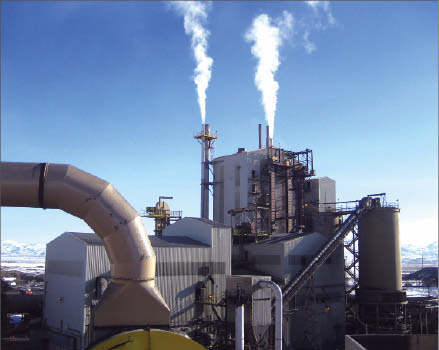Yukon-Nevada Gold (YNG-T) has released a slew of positive drill results as it advances its Jerritt Canyon gold mining complex in northeast Nevada.
The company is drilling many targets on the 285-sq.-km Jerritt Canyon property to upgrade resources, and has recently upgraded its roasting and processing infrastructure, and continues to ramp up production.
Resource conversion drilling at the Starvation target in the property’s southwest is confirming the high-grade nature of the deposit. Highlights from the most recent infill drilling included 29 metres carrying 18.86 grams gold per tonne, 9 metres of 7.68 grams gold and 8 metres of 6.31 grams gold. Measured and indicated resources at Starvation stand at 455,000 tonnes of 9.77 grams gold, while proven and probable reserves stand at 329,000 tonnes of 9.05 grams gold.
The company is looking to get the Starvation deposit into production around September.
“It’s a pretty short development requirement to get it going,” Randy Reichert, chief operating officer of Yukon-Nevada, says by phone of the Starvation target. “There’s not much in the way of underground development.”
The company has also hit high-grade gold at its Mahala targets, sitting between and adjacent to the company’s SSX-Steer and Smith mines in the property’s centre. The company carried out 21,700 metres of diamond and reverse-circulation drilling at the three Mahala zones in 2011.
At the West Mahala zone the company hit 64 metres of 6.38 grams gold from 323 metres depth in hole 457, and 41 metres of 3.67 grams gold from 276 metres depth in hole 468. At the Mahala zone, results include 32 metres of 4.63 grams gold from 279 metres depth in hole 454, and 15 metres of 5.69 grams gold from 242 metres in hole 452. At East Mahala, results include hole 121, which cut 15 metres of 4.77 grams gold from 291 metres depth.
“We’ve had some really good luck in West Mahala . . . and East Mahala,” Reichert says.
The company drilled 40,000 metres in 2011 that it will be incorporating into resource and reserve updates due in April. Yukon-Nevada is also working on a dewatering plan to incorporate even more reserves. As of a Jan. 6 update, proven and probable reserves for the Smith, SSX-Steer, Saval, Starvation, Wright Window and general stockpiles totalled 4 million tonnes grading 5.62 grams gold for 717,000 oz. gold.
At the company’s mill and roaster, located in the northeast corner of its property package, Yukon-Nevada shut down production on Jan. 6 to make upgrades to the dryer, fine-crushing conveying system and distributed control system. The company restarted production with both roasters active on Feb. 3, with production for the month estimated at 9,000 oz. gold with a 3,000-tonne-per-day capacity. By March the company expects to have throughput up to 3,500 tonnes per day and monthly production up to 12,500 oz. gold.
“Production is looking good and we’re looking to have a pretty decent month, and then a really good month next month,” Reichert says.
From there, the company will keep ramping up capacity through the year to 4,200 tonnes per day, pending permitting approval. The plant has 5,400 tonnes per day of capacity but emissions limitations mean further infrastructure investments would be required to move past the 4,200-tonne limit.
Yukon-Nevada is paying for the upgrades thanks largely to forward-gold purchase agreements with Deutsche Bank. In August 2011 Yukon-Nevada closed a US$120-million prepaid deal for delivering 173,880 oz. gold over four years, and on Feb. 8 the company announced a US$20-million deal to forward-sell a further 27,950 oz. gold over 43 months. The US$20-million deal has Deutsche Bank paying US$716 per oz. upfront, and then paying the market price of gold over US$850 per oz. to a maximum of US$1,750 per oz. when the gold is delivered. The US$120-million deal is similarly structured but has a maximum gold price of US$1,950 per oz. gold. Deutsche Bank owns about 11% of Yukon-Nevada.
Reichert said the deals avoided issuing more equity, especially with the company’s share price hurting during development, or dealing with a cumbersome bank loan.
The US$120-million deal was “one of the better mine financing deals completed last year,” Reichert says. “Our feeling was it was fairly low cost compared to the alternatives.”
Gold in Jerritt Canyon occurs as free particles of intergranular, native gold, on or within pyrite, or in association with sedimentary carbonaceous material.
Because of the sulphide and carbonaceous affinities, most of the gold deposits at Jerritt Canyon require fine grinding and oxidation through roasting to allow liberating gold particles by standard, carbon-in-leach cyanidation.
Last year the company bought ore from Newmont Mining (NMC-T, NEM-N) to process at its mill, which, combined with maintenance and development work, added significantly to its production costs. This year the company will be sourcing all of its ore from its own projects and expects more stable production.
Yukon-Nevada also owns the Ketza River historic gold mine in the Yukon, where it is getting permits to restart the mine and mill.
The project hosts 2.4 million measured and indicated tonnes grading 5.46 grams gold for 418,000 contained oz. gold in combined open-pit and underground resources.
On news of the mill restart, the company’s share price climbed 13¢ over two days to close at 44¢, before sliding 3¢ to 41¢ on news of the Deutsche Bank deal. Over three days 11 million company shares were traded, while Yukon-Nevada has 930 million shares outstanding, or 1.08 billion fully diluted.


Be the first to comment on "Yukon-Nevada restarts production at Jerritt Canyon"